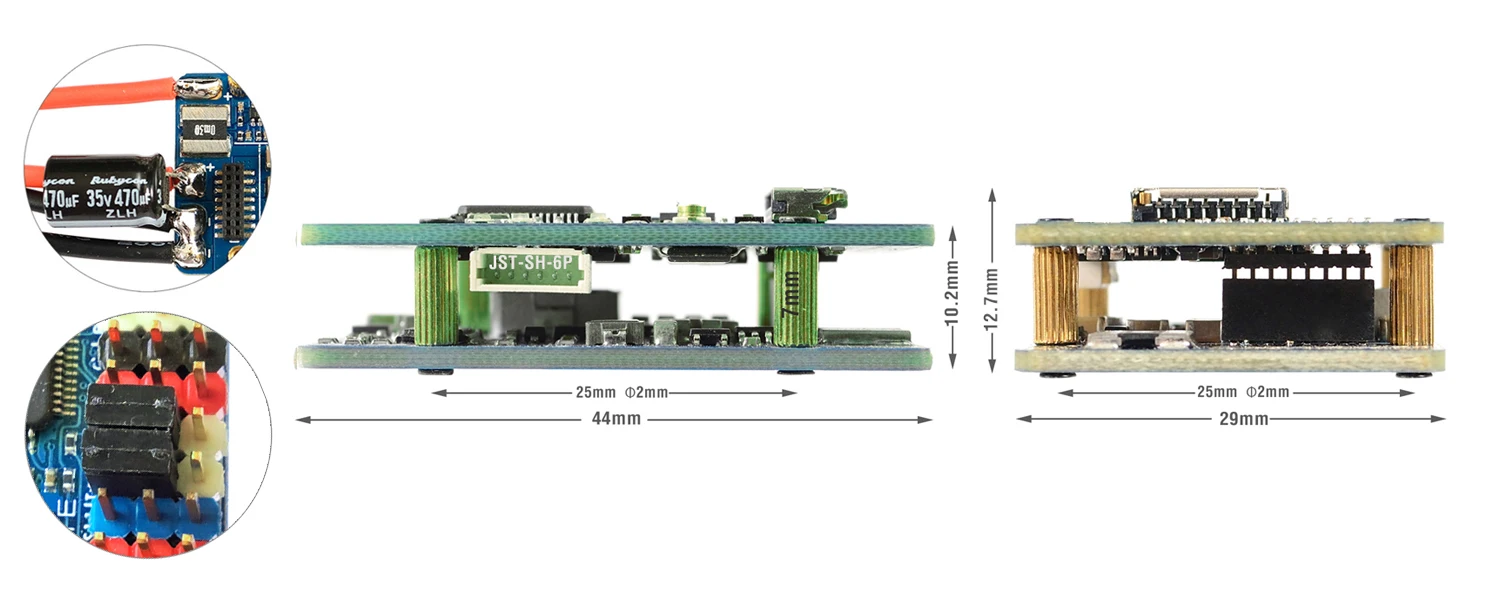
Product
MATEK Mateksys FLIGHT CONTROLLER F405-WTE
Options (1)
Quantity
Share
SPECIFICATIONS
Brand Name: MATEKSYS
Certification: CE
Material: Composite Material
Origin: Mainland China
Recommend Age: 12+y,14+y
Use: Vehicles & Remote Control Toys
FC Specifications
MCU: STM32F405RGT6, 168MHz , 1MB Flash
IMU: ICM42688-P
Baro: SPL06-001
OSD: AT7456E
Blackbox: MicroSD card slot
ESP WiFi Telemetry(MAVLink, 14dBm)
ExpressLRS 2.4G receiver(CRSF protocol, Telemetry 12dBm)
6x UARTs, 1x Softserial_Tx option(INAV)
12x PWM outputs
1x I2C
4x ADC (VBAT, Current, RSSI, Airspeed)
USB/Beep Extender with Type-C(USB2.0)
Dual Camera Inputs switch
9V(12V) for VTX power switch
FC Firmware
ArduPilot: MatekF405-TE
INAV: MATEKF405TE_SD (not available in INAV configurator 4.x)
PDB
Input voltage range: 6.8~30V (2~6S LiPo)
1x ESC power pads
Battery Voltage divider 1K:20K (Scale 2100 in INAV, BATT_VOLT_MULT 21.0 in ArduPilot)
Current Senor: 220A, 3.3V ADC (Scale 150 in INAV, 66.7 A/V in ArduPilot)
Sense resistor: 90A continuous, 220A peak
BEC 5V output
Designed for Flight controller, Receiver, OSD, Camera, Buzzer, 2812 LED_Strip, Buzzer, GPS module, AirSpeed
Continuous current: 2 Amps, Max.3A
BEC 9V /12V output
Designed for Video Transmitter, Camera, Gimbal ect.
Continuous current: 2 Amps, Max.3A
12V option with Jumper pad
for stable 9V/12V output, input voltage should > output voltage +1V
BEC Vx output
Designed for Servos
Voltage adjustable, 5V Default, 6V or 7.2V via jumper
Continuous current: 8 Amps, Max.10A
for stable Vx output, input voltage should > Vx voltage +1V
BEC 3.3V output
Designed for Baro / Compass module and external 3.3V peripherals
Linear Regulator
Continuous current: 200mA
Physical
Mounting: 25 x 25mm, Φ2mm
Dimensions: 44 x 29 x 12.7mm
Weight: 22g w/ USB/buzzer adapter
Including
1x F405-WTE
1x USB(Type-C)/Beep (Passive buzzer) Extender + 20cm JST-SH-6P to JST-SH-6P cable for USB extender.
2x IPEX-MHF1 2.4G Antennas
1x Rubycon ZLH 35V 470uF capacitor
Dupont 2.54 pins (Board is shipped unsoldered)



ArduPilot ESP8266 wifi telemetry
https://ardupilot.org/copter/docs/common-esp8266-telemetry.html
Firmware: firmware-esp01_1m.bin
-
Flashing with ESP_NodeMCU-PyFlasher
Wire the ESP8285(ETx, ERx) into the USB-TTL adapter, with ETx on F405-WTE connected to the Rx on the USB-TTL, and ERx connected to the Tx of the USB-TTL. Wire 4v5 and GND of F405-WTE to 5V and GND of the USB-TTL
Connect USB-TTL Adapter to PC while pressing and holding the ESP8285 boot button in.
open ESP_NodeMCU-PyFlasher
select Serial port of USB-TTL module, load firmware, select “Dual Output(DOUT)” and “Yes.wipes all data“
click “Flash NodeMCU“
after flashing, Power off , then power on F405-WTE by USB or Battery.
Wait a few seconds, search WiFi SSID “ArduPilot”, and password is “ardupilot”
Tips: Red LED for ELRS receiver will not turn on if MAVESP8266 firmware is flashed in.
ExpressLRS 2.4G Receiver
ExpressLRS AUX1-AUX8 are not full resolution CH. https://www.expresslrs.org/2.0/software/switch-config/
-
Flashing via WiFi
Power on F405-WTE by USB, Receiver’s LED(Red) will blink slow at first, and after 30s, it should blink fast indicating it’s on WiFi Hotspot Mode.
More detailed steps, pls refer this page.
Target: DIY 2.4GHz / DIY_2400_RX_ESP8285_SX1280
-
Flashing via UART
Wire the ESP8285(ETx, ERx) into the USB-TTL adapter, with ETx on F405-WTE connected to the Rx on the USB-TTL, and ERx connected to the Tx of the USB-TTL. Wire 4v5 and GND of F405-WTE to 5V and GND of the USB-TTL.
Connect USB-TTL Adapter to PC while pressing and holding the ESP8285 boot button in.
Select the target DIY 2.4GHz / DIY_2400_RX_ESP8285_SX1280 and “UART” for Flashing Method, set your bind phrase and Firmware Options and once done, click on Build and Flash.
UDP Connection with INAV configurator over WiFi
Firmware: MSPWifiBridge_ESP-01.bin compiled based on github.com/Scavanger/MSPWifiBridge
-
Flashing with ESP_NodeMCU-PyFlasher
Wire the ESP8285(ETx, ERx) into the USB-TTL adapter, with ETx on F405-WTE connected to the Rx on the USB-TTL, and ERx connected to the Tx of the USB-TTL. Wire 4v5 and GND of F405-WTE to 5V and GND of the USB-TTL
Connect USB-TTL Adapter to PC while pressing and holding the ESP8285 boot button in.
open ESP_NodeMCU-PyFlasher
select Serial port of USB-TTL module, load firmware, select “Dual Output(DOUT)” and “Yes.wipes all data“
click “Flash NodeMCU“
after flashing, Power off , then power on F405-WTE by USB or Battery.
Wait a few seconds, search WiFi SSID “MSPWifiBridge”, and password is “123456789”
If there is no automatic forwarding to the configuration page, go to http://192.168.4.1 manually. Standard login data: Username: admin, Password: 123456789

No reviews yet. Be the first to leave a review.




